soziale stadt - bundestransferstelle
besonderem Entwicklungsbedarf - Soziale Stadt"
Hamburg-Altona Lurup |
|||||||
|
Ingrid Breckner |
|||||||
Socially integrative urban development has a long tradition in Hamburg. Subsequent to the urban development programmes of the 1970s and 1980s, the "Fight against Poverty" programme was launched in the early 90s. It was followed by state programmes for socially integrative development, which, in Lurup, too, involved residents at an early date, initially in isolated projects.
1. Nature of the Area 
But where is this "Lurup"? Even for Hamburgers it's not easy to say. To the northwest the district borders on the Schleswig-Holstein town of Schenefeld, forming part of the Hamburg boundary (1). The spatially separated Lurup communities "Flüsseviertel" and "Lüdersring/Lüttkamp" (both components of quarter 219 of "Lurup" district in the Hamburg borough of Altona) were combined in 1998 into one support area of the Hamburg urban renewal programme, and since 1999 have been a model area in the "Socially Integrative City "programme of the German federal and state governments.
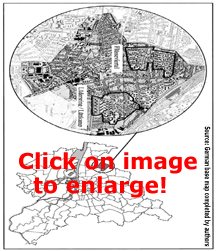 |
The model area in the spatial context (Source: German base map completed by authors) |
In Lurup urban design began in the mid-1950s with a zoning plan. Between 1954 and 1958 the "Elbgaustraße" housing estate was built, including the "Lüttkamp" development. The estate was extended in the 1960s, and development included 10 - 13 storey residential buildings. At the same period the "Flüsseviertel" neighbourhood was built to offer low-income housing in green surroundings for broad sections of the population. As so often in Lurup, greenery was not limited to the area directly surrounding buildings. Residents were already cultivating several allotment garden colonies which have been retained to this day. The youngest part of the model area on "Lüdersring" dates from the 1970s. Large residential blocks with between 3 and 13 storeys were built here, too, in response to the housing shortage that prevailed at the time. These estates are interspersed by single-family houses with small gardens; some surviving farm houses recall the preurban history of this residential environment.
The structure of the Lurup area calls for differentiated spatial analysis, since Flüsseviertel with its rather low buildings and abundant greenery was designed as a "garden city," and Lüdersring/Lüttkamp is a large, populous estate, both areas adjoining lower-middle-class residential neighbourhoods. For example, there are considerable differences between the two parts of the model area as regards the proportion of foreign residents. Whereas a disproportionate number of foreigners live in Lüdersring/Lüttkamp, Flüsseviertel is at the average level for Hamburg. The statistics are only conditionally informative because foreigners with German passports living in Lurup are not recorded separately - and the younger generation in this category of resident are an important target group for social work and socially integrative urban development.
 |
| Oblique photograph of the area "Lüdersring/Lüttkamp," part of the model area (Source: Photographer Gunnar Johannson, Hanseatische Luftfoto GmbH, in: Hamburger Abendblatt (ed.), Unter dem Himmel von Hamburg. Die Stadt aus der Luft, Hamburg 1979, p. 64, - own processing..) |
Life situations and needs in the model area can be differentiated by generation, owing to the high proportion of younger and older people. According to the housing company SAGA, which owns most housing in the model area, growing resident fluctuation and declining ties with the neighbourhood are to be expected owing to the pending generation shift and generally higher mobility among younger households.
2. Main Problems and Development Potential 
Social-space difficulties in the model area range from structural housing problems, work, and transport to generational conflicts, poverty and unemployment, spatial polarisation and the stigmatisation of deprived areas. In combination with the structural described, these problems become ruinous.
Generational conflicts arise between older people who have lived in the neighbourhood for a long time and children and adolescents. Older people find it hard to accept the difficulties of younger people who move into the neighbourhood or who are growing up there. They do not understand why they spend so much of their time together in public places ("haven't you go a home to go to?"), feel disturbed by exuberant play, suspect young people of having criminal intentions, and find their foreign appearance and everyday practices a provocation.
However, generational conflicts also occur within households between parents and their offspring. The neighbourhood management has to deal with both forms of conflict in improving the quality of sojourn in public spaces for one group or another, or in organising "conflict management" for neighbourhoods.
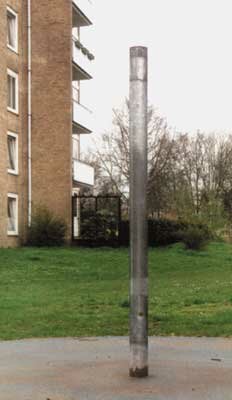 |
Memorial to a conflict: the remains of a children's' roundabout that had to be dismantled after protests from older residents. (Source: Sabine Tengeler, Hamburg) |
Poverty and unemployment in the model area go hand in hand with a low level of education and training. The general secondary school qualifications needed for placement in the primary labour market are often not achieved in Lurup (in the city as a whole, an average 28% of students leave general secondary school without qualifying examination) (2). In addition, the poorly qualified labour available in Lurup does not correspond to demand in the Hamburg economy. For many residents, difficult personal circumstances are often coupled with mobility barriers, for example among the large group of single mothers in Lurup with their families (3). Moreover, a pattern of life often repeats itself over several generations that leads to dependence on social assistance. Young girls often emancipate themselves from the parental home by founding a family of their own. A lack of qualifications, a lack of child care facilities in the immediate vicinity and available at appropriate times produces permanent new dependence, this time on the partner or the State.
Demography and Social Space
|
Flüsseviertel |
Lüdersring/ |
Lurup |
Altona |
Hamburg |
|
|
Size (1) |
82 ha |
100 ha |
556 ha |
6 303 ha |
63 377 ha |
|
Population (2000) |
5 149 |
6 190 |
32 089 |
240 102 |
1 704 929 |
|
Population dev. (1995-2000) |
+ 8.1 % |
0.0 % |
+ 22.1 % |
- 0.4 % |
- 0.6 % |
|
Average household size (2000) |
2.3 pers. (2) |
2.4 pers. (2) |
.2.1 pers. |
1.9 pers. |
1.9 pers. |
|
Number of dwellings (2000) |
1 982 (2) |
1 314 (2) |
14 286 |
116 583 |
852 919 |
|
Vacant dwelling units (2000) |
14 WE (3) |
2 WE (3) |
n.a. |
n.a. |
n.a. |
|
Housing benefit recipients |
n.a. |
n.a. |
n.a. |
n.a. |
n.a. |
|
Unemployment rate (2000) |
- (4) |
- (4) |
8.0 % |
6.5 % |
6.1 % |
|
Social assistance recipients (2000) |
- (4) |
- (4) |
10.1 % |
6.6 % |
7.1 % |
|
Foreign population (1999) (5) |
16.0 % |
23.0 % |
14.5 % |
17.6 % |
16.0 % |
|
Population under 18 (2000) |
21.8 % |
21.0 % |
19.8 % |
16.5 % |
16.1 % |
|
Population 65 and older (2000) |
17.2 % |
16.2 % |
18.3 % |
17.0 % |
17.0 % |
|
|
|||||
Polarisation and the stigmatisation of deprived areas are generated in Lurup by the spatial concentration of publicly-assisted housing and its occupancy. The income level set by federal law, which has not been adjusted to actual developments for many years, prerequisite for allocation of social welfare housing, and the comparatively high rents in the Lurup categories of publicly-assisted housing have concentrated structural and social problems in certain buildings and certain localities. Sweeping judgments along the lines: "that's where the social misfits live" help to propagate the negative image of an otherwise innocuous district - among Lurup residents themselves and among other inhabitants of the city. Such stigmatisation makes it more difficult for people to identify with where they live, the fundamental precondition for a common commitment and willingness to resolve conflicts. Many residents shut themselves off from their immediate neighbourhood. The people involved are often incapable of handling neighbourhood disputes in a civil manner, containing power struggles between various youth groups, or settling the "generational conflicts" mentioned above. They need support in developing a culture of mutual recognition, which seems scarcely feasible without some sort of socio-economic perspective.
There is potential for development not only in Lurup's heterogeneous spatial structure and the possibility of combining innovative urban renewal with social measures but also in communication structures and self-help activities, traditional and new networks, and in institutions that specifically address the interests of the district. Treated below in greater detail are the potentials for socially integrative development that have grown since 2000 and which can be an innovative complement to urban renewal measures.
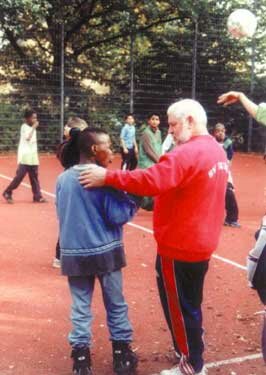 |
The Lurup Sports Club is an active partner in the district network. Since October 2001 donations have provided a sports equipment rental business and on-the-spot training facilities in cooperation with many actors. (Source: Sabine Tengeler, Hamburg) |
Examples for communication and first approaches towards self-help in "loose alliances" of like-minded people are the anglers' group "Goldi", the young people's "Soccer Club" and the "Youth Container" set up in early 2002 with the help of the neighbourhood management but operated under a self-organisation regime. In addition, three mothers' groups are tackling the equipment and upkeep of playgrounds as places of communication. Among the concerns of a Turkish mother and child group are interethnic exchanges in the neighbourhood. Occasions for social get-togethers are organised by a senior citizens' group and cross-generational activities by the "Flea Market Group." The "Lurup Forum," which had been in the course of revitalisation operates as a venue where people can talk about current events in the district.
District networks have developed in Lurup in traditional form in the "Lichtwark Committee" and - in a more modern variation - in the "Lurup Women's Oasis." The "Lichtwark Committee," constituted as an association, depends on the unpaid commitment of old-established Lurup residents. It collects money from local business to help the needy in the district and organises activities (like the annual district festival) that encourage communication among Lurup residents. Networks like the "Lurup Sports Club" bundle existing relations, knowledge, and competencies (4). The "Lurup Women's Oasis" is a new network of committed women that aims to establish a hamam, an oriental bathhouse. Work on the project has brought together women from many backgrounds, and the venture is expected to attract attention far beyond the district among authorities, associations, and municipal organisations, as well as private sponsors, users, and investors.
There is institutionalised development potential in Lurup in child and youth welfare services, in school contexts, local parish activities, housing companies, and in the new neighbourhood management. One example is the child and family centre "KifaZ," the outcome of a self-help initiative, which opened in Flüsseviertel in the spring of 2000. Sponsored by the German Child Protection Association, this new facility with its unusual approach has rapidly become a meeting place for all age groups and an important district communication hub. The "Open District Centre" offers advice on specific issues. The café, open three times a week, provides not only reasonably priced meals but also contacts on a range of social issues. The Lurup "Böverstland" association (Böv 38 e.V.), too, is playing an increasingly important role in the field of psychological and physical health services in the district. A local secondary school is active in the "work and employment" working party of the "Lurup Forum," which aims to provide young people with opportunities to get started in employment. The local parish offers its premises for private and district-related festivities. Staff of the local housing company SAGA support the social development of the district with measures for constructional improvements to housing and the residential environs in cooperation with the Office for Urban Renewal of the competent authority and local institutions. The neighbourhood management links up these diverse resources to ensure mutual information, capabilites, and reflection on approaches to achieving joint development of the neighbourhood.
3. Development Goals and Focus Point of Action in Local Practice 
On the basis of previous neighbourhood improvement activities and the 1998 project and action plan, the first draft neighbourhood development concept of November 2000 took as its aim the activation, support, and fruitful interlinkage of existing local potentials with city-wide resources. Since its establishment in the spring of 2000, the neighbourhood management has supported the "Citizens' Forum," an institution founded on the personal initiative of its members. The District Centre inaugurated in June 2000 has rapidly developed into a contact point and a focus of communication in the district. Growing "civic awareness" has provided a basis for addressing existing conflicts and for developing problem-solving strategies in a spirit of partnership. The expanded district newspaper (see 4 "Key Projects") provides an appropriate public medium for these communicative and conceptual processes with a reach far beyond the boundaries of the district, and which can supplement internal interchanges by activating external support.
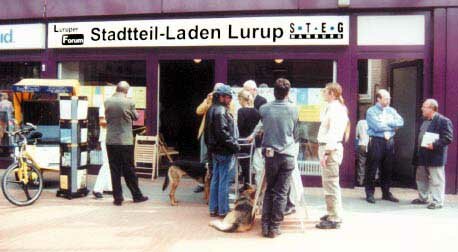 |
| The Lurup District Centre: Presentation of Lichtwark Committee's brochure "Our Lurup," and the "district poster" issued by the neighbourhood management (STEG). (Source: Sabine Tengeler, Hamburg) |
The aim of neighbourhood development is also to promote "training and employment" for Lurup residents. At the request of the neighbourhood management and the competent authorities, the local programme support team provides particular assistance in this field. Taking unsettled issues as the point of departure in a first discussion between the chambers of commerce and industry, the employment office, craft businesses, and representatives of schools, the programme support team carried out an explorative analysis of the existing and as yet unqualified labour supply and the demand for labour in local enterprises. The findings were presented to Lurup actors and the Hamburg expert public at the conference on "Work and Employment" in April 2001. Interfacing between schools and business proved deficient. On the basis of existing resources at Veermoor School, contact networks have been established or expanded with enterprises in the environs of the model area, which enable company traineeships for teachers and practical training and training positions for students. At a "careers information day" in late November 2001, teachers and students from several schools established contact with participating companies. From 2002 onwards, the neighbourhood management will be specifically addressing the subject of "school, training and employment." Vermoor School has been promised further support for prevocational training activities by the Office for Schools.
Another highly important goal is the development of project ideas "from the neighbourhood." Using the participatory and activation techniques mentioned below, the neighbourhood management aims to take up ideas and to formulate them in such a way that they can be "understood" and processed by the forum and the relevant authorities. Expert advice is organised to help in the conceptual planning of more complex projects, like the "Lurup Women's Oasis." This goal is to be pursued in all areas of socially integrative development in Lurup: "citizen participation and district life," "work, training and employment," "local economy and local services," "social infrastructure," "health," "housing," "residential environment and open spaces," and "transport and mobility" (see QEK 2000).
The activation and involvement of residents and the generation of project ideas in the district are intended to help improve the life situation of a wide range of neighbourhood residents. It is hoped to generate a gradual, positive identification with local conditions that can counteract the increasingly negative image of the district. The goals and implementation strategies in the areas of action for socially integrative development are under constant review. Shifts in emphasis and changes among the "comrade-in-arms" who support implementation are taken into account in each new version of a neighbourhood development concept, rendering future options for action and learning processes fully transparent.
4. Key Projects 
Among the multitude of problems and resources in Lurup, two projects can be identified as "key projects" in the current development phase.
The district newspaper "Lurup im Blick" (5) is brought out jointly by the self-organised district advisory council "Lurup Forum" and the neighbourhood management. It provides for information and district marketing with the aim of enhancing the image of the area. Journalists working largely in an honorary capacity provide PR for projects and activities in the neighbourhood, and thus for the "Socially Integrative Development" programme. The newspaper also publishes the official invitation to the "Lurup Forum" (district advisory council) and the minutes of meetings. The public are invited to collaborate on and participate in specific projects, in organising smaller events, and the like. Most contributions are penned by Lurup residents. Articles are edited in close collaboration with authors, taking into account their originality and individuality, allowing even less experienced residents to put their points of view. Reports thus tie in with the everyday life and world of local residents. Numerous pictures say what words alone cannot express. Political and administrative authorities are accordingly provided with graphic insight into local developments. The newspaper targets both local actors (residents, local business, social and cultural institutions, housing companies, etc., etc.) and officials at the borough and city-state levels, as well as members of various political decision-making bodies.
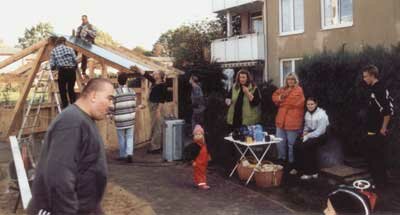 |
In October 2000 a group of residents built a "dwarves' hut" to the plans of wood designer Detlef Duske. (Source: Sabine Tengeler, Hamburg) |
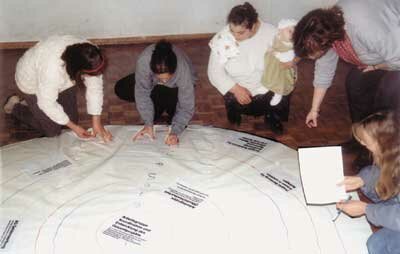 |
Projects on target: At a workshop organised by the Lurup Women's Oasis, women place cards with project ideas on a large target. (Source: Sabine Tengeler, Hamburg) |
The second key project in neighbourhood development is the "Job Club Mobil." It aims to provide an on-the-spot advisory service for young people and the long-term unemployed. After first practical experience since the spring of 2001 in the District Centre and the Child and Family Centre, the project has had its own bus since 2002. Staff from an employment agency offer an open and low-threshold information and advisory service at various places in the area. Since this service is mobile, it regularly and dependably reaches young people and adults who do not avail themselves of the central integration services offered by other institutions or public authorities. Social counselling is linked with occupational help, and, offered in cooperation with existing neighbourhood institutions, constitutes a multifaceted invitation to "self-help" consistent with residents' everyday life.
5. Organisation and Management 
Key projects and many of the smaller measures undertaken in the neighbourhood involve a multiplicity of actors in the realisation of ideas and concepts. While the "Lurup Forum" brings together active groups and people in the district at its monthly meetings in various places, the District Centre offers a fixed meeting place, a daily contact point in the neighbourhood. This is also where the neighbourhood management has its office, where various institutions offer their advisory services, where the district newspaper is put together, where working groups meet, etc., etc. At the District Centre, the "neighbourhood development" working group is currently revising the first draft of the neighbourhood development concept under the overall control of the neighbourhood management. The purpose of the neighbourhood development concept is to permit practicable and transparent development planning. With the assistance of the borough commissioner and the competent urban development authority, the neighbourhood management constitutes the key interface between "administration and politics" on the one hand and the various neighbourhood actors on the other. Besides elaborating the neighbourhood development concept, the neighbourhood management is responsible for the following:
- the development and coordination of specific projects in collaboration with local actors and the relevant authorities,
- ensuring implementation and day-to-day support of projects,
- the development and implementation of project-related local forms of cooperation involving the greatest possible number of affected residents,
- regular cooperation with the borough and other competent authorities (see overview "Organisational Structures for Programme Implementation in Hamburg-Altona-Lurup") and with relevant institutions acting in the public interest, and, finally:
- providing the borough office with complete reports on the progress of work and active collaboration in evaluation measures required by the borough office in consultation with the urban development authority. (6)
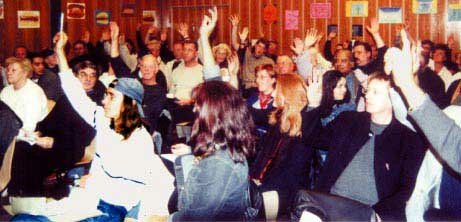 |
| The Lurup Forum: voting on the allocation of Euro 2,604 from the fund on hand for a youth container to be operated on a self-help basis. (Source: Sabine Tengeler, Hamburg) |
Local residents and institutions are also directly involved in local politics through the "Lurup Forum" - its composition varies depending on the issues treated; between 40 and over 100 people participate. In the twelve-member, annually elected management of the "Lurup Forum" local residents are joined by representatives of local politics, the business community, and the staff of social institutions, district civic action groups, and the housing company. The management discusses projects to be financed from the contingent fund or other grants before they are submitted to the forum by the actively involved people themselves. The ground is thus prepared for consensus, central issues can be considered in advance. The forum management is elected by members entitled to vote (everyone who lives or works in the neighbourhood and has attended the forum at least twice).
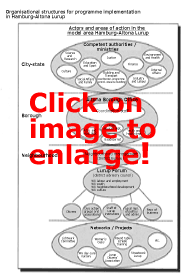 |
Organisational structures for programme implementation in Hamburg-Altona Lurup |
Within the borough of Altona, a "coordinating staff" accountable directly to the borough director is entrusted with coordinating implementation of the programme. Members inform about links, goals, and achievements in neighbourhood development within Altona, i.e., in the various administrative departments. They inform the elected members of the borough council, directly and indirectly via other administrative units and agencies, and consult with the competent committees set up by the borough council and with subordinate units (like the child welfare office) on the situation in the area and what action is to be taken. At the borough council committee level, control of the programme is assigned to the local committee.
The coordinating staff and, in particular, the area commissioner responsible for Lurup collaborate closely with the neighbourhood management. Members of the coordinating staff thus support the neighbourhood management in communicating socially integrative development matters to the competent authorities and winning their cooperation. This continuous process of communication and coordination reaches its greatest intensity during work on the neighbourhood development concept to be submitted to the competent authorities and the Senate of the Free and Hanseatic City of Hamburg.
More so than in a non-city state, the authorities in Hamburg communicate directly with the actors in neighbourhood development. In Hamburg, responsibility for socially integrative district development was initially entrusted to the "Urban Development Authority" which was integrated into the new "Authority for Building and Transport" after the election on 21 September 2001. Over and above the preceding coordination rounds, consultations are held under its control once a year on the measures and projects planned and to be implemented in the areas. Ten organisational units have the opportunity to gain an overview of current work in the Hamburg socially integrative district development areas and to participate constructively, for example, through resource bundling.
6. Activation, Participation, and Public Relations 
Since the activation and involvement of local actors are among the key goals of neighbourhood development in Hamburg-Altona-Lurup, almost all conceivable instruments are employed with varying intensity. As in North Rhine-Westphalia, the "District Centre" has proved an essential prerequisite for establishing contact in every respect: Between the neighbourhood population and the district management, as well as between active individuals and those who would like to take part. Its location in a shopping centre close to the suburban railway station has proved very favourable, since it allows people to "drop by" without obligation. The District Centre is open to the public daily from 10 a.m. to 5 p.m. In addition to the many organised activities of specific projects and institutions/actors from within and outside the neighbourhood (workshops, "planning for real," symposiums and discussion groups, activities and campaigns for specific target groups, competitions, etc.), which use the District Centre as an assembly point and for public relations, people meet in the centre for a wide range of major and minor matters.
The neighbourhood management operates under the motto of proximity to the citizen and low thresholds. "Activation" is pursued specifically in continuous contact with as many groups and communities in the neighbourhood as possible, either directly or via "key people." "Being in touch with the neighbourhood" was particularly important in the first two years of the project, and trust was not automatically forthcoming. It depends on personal preconditions, and requires constant nurturing. If no direct contact can be established, key persons, a businessman, a kindergarten director, or a "quite normal citizen" with strong influence in a given group can mediate. Such key people are an important, more or less covert "resource" of the area. Institutionalised forms of participation, which make use of constantly changing network formations, include the forum, district conferences of social institutions, working parties and groups, the "round table" on specific issues, as well as tenant groups, the citizens' association, and the school parent-teacher associations.
Lurup offers an extremely wide spectrum of activation and participation forms, which are repeatedly supplemented; some die off because objectives have been attained or momentum and interest wane. The instrument of the "contingent fund" is particularly important in this respect. In the context of "socially integrative district development" in Hamburg, neighbourhoods are allocated up to Euro 20,830 per year for direct and unbureaucratic use in developing and implementing projects. The employment of this money is decided locally by the "Lurup Forum." Citizens assume financial responsibility and - where necessary with expert advice - set spending priorities by democratic vote. The fund is used to finance smaller, self-sufficient measures (e.g., support for individual and group activities, public relations, events, equipment and materials, and smaller investments). Concrete results are rapidly visible - an indispensable precondition in fostering activation and participation.
7. Conclusion: future prospects 
- The deficiencies in the model area spatial structure dating from the 1950s, 1960s, and 1970s cannot be remedied with neighbourhood development resources alone. Classical urban development support for investment adapted to local needs will therefore need to be continued.
- Low levels of education, low incomes, and social burdens due to migration or child-rearing obligations bind residents to their accustomed surroundings. Nevertheless, commercial and industrial milieus outside the neighbourhood need to be accessed for unemployed Lurup residents, mobility barriers eliminated, and reliable support in training and employment provided.
- In Lurup, as elsewhere, projects and the organisations that support them do not come about of themselves. The path of a project from initial conception to implementation needs reliable and consistent professional assistance. In this respect, too, it is necessary to link local and municipal resources and strategies for action.
- Local networks oft lack suitable access to decision-makers in the competent authorities. The more precisely and rapidly the neighbourhood management is informed about what the various authorities offer, the better will it be able to mediate the necessary contacts.
- Socially integrative development needs time. Depending on conditions and previous experience in specific areas, a range of issues can be tackled and action dynamics actualized. The more stable and well-founded the first steps are, the more likely it is that social structures will develop that require progressively less outside support.
References
(1) Other "neighbours" are Gross-Flottbek and Osdorf to the south and Bahrenfeld and Eidelsedt to the east. ![]()
(2) Source: http://www.zeit-stiftung.de/lernwerk-hh/hauptschule.htm ![]()
(3) Some 25% of all households dependent on social assistance are single parent households. ![]()
(4) In their turn they use the "Lurup Forum" as public communication medium (cf. overview "Organisational Structures for Programme Implementation in Hamburg-Altona-Lurup" in 5 "Organisation and Management"). ![]()
(5) The newspaper has existed since October 1998, and since April 2001 it has appeared more frequently, with ten issues per year, owing to the support provided by the neighbourhood management. The district newspaper is financed by the state and federal programme on socially integrative urban development and from private sources. Knock-on financing came from special funds of the Hamburg-Altona borough authority (cf. overview ("Organisational Structures for Programme Implementation in Hamburg-Altona-Lurup" in 5 "Organisation and Management"). ![]()
(6) For these tasks the neighbourhood management has Euro 158.000 per annum available. ![]()
Im Auftrag des BMVBS vertreten durch das BBR. Zuletzt geändert am 25.05.2005